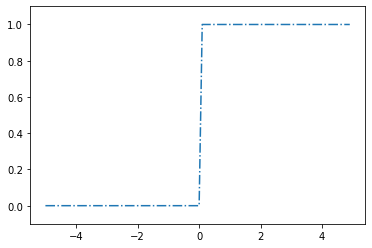인공지능
[밑바닥부터 시작하는 딥러닝] Part_1/CHAPTER 3 신경망/CHAPTER 3 신경망
SBOX Learning by doing
2022. 7. 23. 16:09
반응형
밑바닥 부터 시작하는 딥러닝
계단 함수 구현하기
In [3]:
import numpy as np
x = np.array([-1.0, 1.0, 2.0])
x
Out[3]:
array([-1., 1., 2.])In [4]:
y = x > 0
y
Out[4]:
array([False, True, True])In [5]:
y = y.astype(np.int)
y
Out[5]:
array([0, 1, 1])계단함수의 그래프
In [18]:
import numpy as np
import matplotlib.pylab as plt
def step_function(x):
return np.array(x > 0, dtype = np.int)
x = np.arange(-5.0, 5.0, 0.1)
y = step_function(x)
plt.plot(x,y,'-.')
plt.ylim(-0.1, 1.1) # y축의 범위 지정
plt.show()

시그모이드 함수 구현하기
In [7]:
def sigmoid(x):
return 1 / (1 + np.exp(-x))
In [8]:
x = np.array([-1.0, 1.0, 2.0])
In [9]:
sigmoid(x)
Out[9]:
array([0.26894142, 0.73105858, 0.88079708])In [12]:
x = np.arange(-5.0, 5.0, 0.1)
y = sigmoid(x)
plt.plot(x,y)
plt.ylim(-0.1, 1.1) # y축의 범위 지정
plt.show()

ReLU함수
In [19]:
def relu(x):
return np.maximum(0, x)
In [20]:
x = np.array([-1.0, 1.0, 2.0])
In [21]:
relu(x)
Out[21]:
array([0., 1., 2.])In [24]:
x = np.arange(-5.0, 5.0, 0.1)
y = relu(x)
plt.plot(x,y)
plt.show()

다차원 배열의 계산
다차원 배열
In [26]:
import numpy as np
A = np.array([1, 2, 3, 4])
print(A)
[1 2 3 4]
In [27]:
np.ndim(A)
Out[27]:
1In [28]:
A.shape
Out[28]:
(4,)In [30]:
A.shape[0]
Out[30]:
4In [31]:
B = np.array([[1, 2], [3, 4], [5, 6]])
print(B)
[[1 2]
[3 4]
[5 6]]
In [32]:
np.ndim(B)
Out[32]:
2In [33]:
B.shape
Out[33]:
(3, 2)행렬의 곱
In [34]:
A = np.array([[1, 2], [3, 4]])
A.shape
Out[34]:
(2, 2)In [35]:
B = np.array([[5, 6], [7, 8]])
B.shape
Out[35]:
(2, 2)In [36]:
np.dot(A, B)
Out[36]:
array([[19, 22],
[43, 50]])In [37]:
A = np.array([[1, 2, 3], [4, 5, 6]])
A.shape
Out[37]:
(2, 3)In [38]:
B = np.array([[1, 2], [3, 4], [5, 6]])
B.shape
Out[38]:
(3, 2)In [39]:
np.dot(A, B)
Out[39]:
array([[22, 28],
[49, 64]])In [40]:
C = np.array([[1, 2], [3, 4]])
C.shape
Out[40]:
(2, 2)In [41]:
A.shape
Out[41]:
(2, 3)In [42]:
np.dot(A, C)
---------------------------------------------------------------------------
ValueError Traceback (most recent call last)
<ipython-input-42-bb5afb89b162> in <module>
----> 1 np.dot(A, C)
<__array_function__ internals> in dot(*args, **kwargs)
ValueError: shapes (2,3) and (2,2) not aligned: 3 (dim 1) != 2 (dim 0)신경망에서의 행렬 곱
In [43]:
X = np.array([1, 2])
X.shape
Out[43]:
(2,)In [44]:
W = np.array([[1, 3, 5],[2, 4, 6]])
print(W)
[[1 3 5]
[2 4 6]]
In [47]:
W.shape
Out[47]:
(2, 3)In [46]:
Y = np.dot(X, W)
print(Y)
[ 5 11 17]
각 층의 신호 전달 구현하기
In [50]:
X = np.array([1.0, 0.5])
W1 = np.array([[0.1, 0.3, 0.5], [0.2, 0.4, 0.6]])
B1 = np.array([0.1, 0.2, 0.3])
print(W1.shape) # (2, 3)
print(X.shape) # (2,)
print(B1.shape) # (3,)
A1 = np.dot(X, W1) + B1
Z1 = sigmoid(A1)
print(A1)
print(Z1)
(2, 3)
(2,)
(3,)
[0.3 0.7 1.1]
[0.57444252 0.66818777 0.75026011]
In [55]:
W2 = np.array([[0.1, 0.4], [0.2, 0.5], [0.3, 0.6]])
B2 = np.array([0.1, 0.2])
print(Z1.shape)
print(W2.shape)
print(B2.shape)
A2 = np.dot(Z1, W2) + B2
Z2 = sigmoid(A2)
(3,)
(3, 2)
(2,)
In [58]:
def identity_function(x):
return x
W3 = np.array([[0.1, 0.3], [0.2, 0.4]])
B3 = np.array([0.1, 0.2])
A3 = np.dot(Z2, W3) + B3
Y = identity_function(A3)
In [64]:
def init_network():
network = {}
network['W1'] = np.array([[0.1, 0.3, 0.5], [0.2, 0.4, 0.6]])
network['b1'] = np.array([0.1, 0.2, 0.3])
network['W2'] = np.array([[0.1, 0.4], [0.2, 0.5], [0.3, 0.6]])
network['b2'] = np.array([0.1, 0.2])
network['W3'] = np.array([[0.1, 0.3], [0.2, 0.4]])
network['b3'] = np.array([0.1, 0.2])
return network
def forward(network, x):
W1, W2, W3 = network['W1'], network['W2'], network['W3']
b1, b2, b3 = network['b1'], network['b2'], network['b3']
a1 = np.dot(x, W1) + b1
z1 = sigmoid(a1)
a2 = np.dot(z1, W2) + b2
z2 = sigmoid(a2)
a3 = np.dot(z2, W3) + b3
y = identity_function(a3)
return y
network = init_network()
x = np.array([1.0, 0.5])
y = forward(network, x)
print(y)
[0.31682708 0.69627909]
항등 함수와 소프트맥스 함수 구현하기
In [65]:
a = np.array([0.3, 2.9, 4.0])
exp_a = np.exp(a)
print(exp_a)
[ 1.34985881 18.17414537 54.59815003]
In [67]:
sum_exp_a = np.sum(exp_a)
print(sum_exp_a)
74.1221542101633
In [68]:
y = exp_a / sum_exp_a
print(y)
[0.01821127 0.24519181 0.73659691]
In [69]:
def softmax(a):
exp_a = np.exp(a)
sum_exp_a = np.sum(exp_a)
y = exp_a / sum_exp_a
return y
In [73]:
def softmax(a):
c = np.max(a)
exp_a = np.exp(a - c) # 오버플로 대책
sum_exp_a = np.sum(exp_a)
y = exp_a / sum_exp_a
return y
In [74]:
a = np.array([0.3, 2.9, 4.0])
y = softmax(a)
print(y)
[0.01821127 0.24519181 0.73659691]
In [79]:
np.sum(y)
Out[79]:
1.0In [85]:
pip install dataset.mnist
Note: you may need to restart the kernel to use updated packages.
ERROR: Could not find a version that satisfies the requirement dataset.mnist (from versions: none)
ERROR: No matching distribution found for dataset.mnist
In [2]:
import sys, os
sys.path.append(os.pardir) # 부모 디렉터리의 파일을 가져올 수 있도록 설정
from dataset.mnist import load_mnist
#처음 한 번은 몇 분 정도 걸립니다.
(x_train, t_rain), (x_test, t_test) = load_mnist(flatten=True, normalize=False)
#각 데이터의 형상 출력
print(x_train.shape) # (60000, 784)
print(t_train.shape) # (60000,)
print(x_test.shape) # (10000, 784)
print(t_test.shape) # (10000,)
---------------------------------------------------------------------------
ModuleNotFoundError Traceback (most recent call last)
<ipython-input-2-c6d61f47d836> in <module>
1 import sys, os
2 sys.path.append(os.pardir) # 부모 디렉터리의 파일을 가져올 수 있도록 설정
----> 3 from dataset.mnist import load_mnist
4
5 #처음 한 번은 몇 분 정도 걸립니다.
ModuleNotFoundError: No module named 'dataset.mnist'반응형